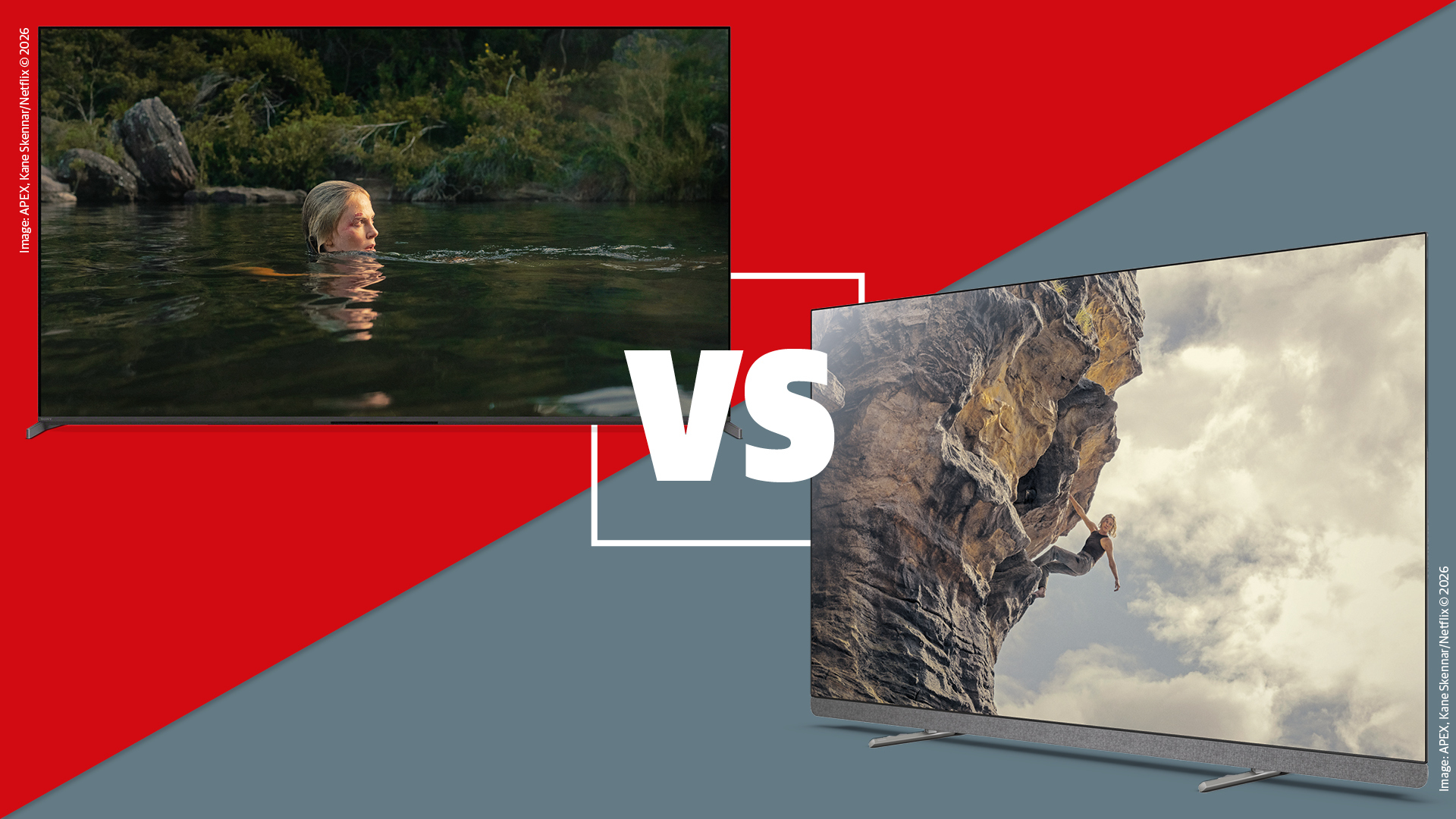What Hi-Fi? Verdict
The Samsung's all-powerful Smart Hub and natural pictures are sure to impress but the best deliver better black detail
Pros
- +
Fantastic smart features
- +
Natural colour
- +
Sharp, defined detail
- +
Inky blacks
Cons
- -
Voice and gesture control is gimmicky
- -
Expensive
- -
Whites could be punchier
Why you can trust What Hi-Fi?
UPDATE: The Samsung UE55F8000 went from five stars to four stars following a 55in 2013 TV Group Test in our July 2013 issue.
We first set eyes on the Samsung UE55F8000 – Samsung’s flagship LED TV – at CES 2013, in Las Vegas in January. It shared pride of place on Samsung’s stand alongside its plasma F8500 sibling and the S9000 4K Ultra HD series.
The Samsung UE55F8000, then, is the first of 2013’s new ranges that we’ve got our hands on for review, and we’re excited.
MORE: Samsung PS51F8500 review
This TV is a 55in LCD/LED Full HD Smart 3D set, and will cost you a not inconsiderable £2500. For that you get a substantial redesign over 2012’s models, and smarter features to entice both tech-lovers and the casual viewer.
Samsung UE55F8000 review: Design
At first glance, the screen itself looks elegant and sleek. That could be said about quite a few flatscreen TVs, of course, but the Samsung UE55F8000 really looks the part.
The latest hi-fi, home cinema and tech news, reviews, buying advice and deals, direct to your inbox.
A single piece of aluminium – Samsung is calling this style ‘Magnum’ – frames the 55in screen, with a slim bezel that shows off the full screen for immersive viewing. It feels premium quality as well. Measuring a slim 3.5cm in depth, the set feels rather light for a 55in screen: 17kg for the screen itself, and 18kg including the stand.

Now, the stand… We need to talk about the stand. The metal arc stand is designed to create a ‘floating display’ – and it does so rather elegantly. It’s certainly a good-looking design, and easy to set up (just a few screws and it slots into place easily), but there is a caveat.
It’s as wide as the screen itself: measuring 120cm, therefore, it’s too big for most standard-issue AV racks. Indeed, the stand hung over the edges of all the racks we use in our testing rooms – which leaves it prone to tilting forward if there’s the slightest push. Even if the support under the stand is wide enough, this is still a less-rigid design than used in 2012.
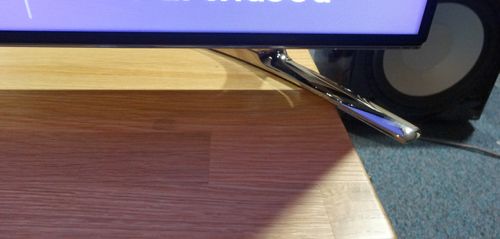
Samsung UE55F8000 review: Tech specs
The Samsung UE55F8000 has an edge-lit LED display, with a Full HD resolution of 1920x1080 pixels – standard fare. What’s not standard is that this set features a quad core processor inside – a world first for Smart LED TVs.
It’s the crucial component that drives all the smarter upgrades and performance of the 2013 LED TV range: faster web browsing and multitasking, and clearer picture quality are all on the cards.
Connections are all housed neatly at the back of the TV: there are four HDMI inputs, along with three USB ports (one for recording), as well as component and composite inputs, a digital optical output, a headphone out, and an RGB scart input.
MORE: Samsung buys 3% stake in Sharp
The 55UEF8000 offers an ethernet LAN port for wired connection as well as built-in wireless connectivity. And for its main purpose it has one Freeview HD tuner, and one Freesat tuner with two feeds (a bit like a Sky box).
Samsung is offering a Smart Evolution kit that slots into the back of your new Samsung TV. This will allow you to upgrade the set every year to take in the latest technology in terms of performance, content and features, and is valid for up to four years.
Some of last year’s sets also have this feature, which means you can upgrade the 2012 Samsung Series 7, 8, and 9 sets to this year’s specification – the module will cost you around £280.

Samsung UE55F8000 review: Set up
We’d recommend taking time to fine tune the screen to get the best possible picture. When first turned on, it looks overly etched and washed-out – this isn’t the exciting Samsung picture we’ve become accustomed to. We delved into the menus and started to fiddle around with the exhaustive picture settings to get it looking right – it takes quite a long time.
(Top tip: pick a Blu-ray film you’ve seen a couple of times – so you know exactly how the picture should look; we chose J J Abrams’s 2009 Star Trek.)
Samsung has provided its own test patterns in their advanced picture settings, but they’re no match for our trusty THX Optimiser disc. And all our tweaking was worth the effort. Once correctly calibrated, the screen jumped to life.
Notable tweaks included turning down the backlight, contrast and brightness levels, while we turned off the noise filters and motion processing. It’s always worth playing around with all these settings to see what each does, and to fine-tune them to your personal viewing tastes.
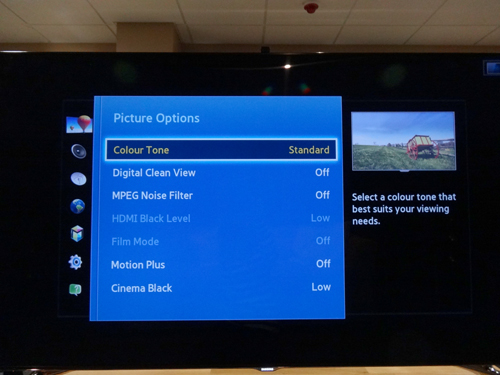
Samsung UE55F8000 review: Features
One of the first things we spotted on our casual inspection of the UE55F8000 was that the built-in camera is hidden away at the top. Push down on it, and it smoothly pops out of the frame – it’s a nifty little design feature.
Use the 5MP camera for face recognition login into your Samsung account, for Skype, and for activating all the motion controls. Gamers take note: you might find the camera placement a bit impractical when attaching games console peripherals that demand to be placed on top of a TV – it’s an issue for any TV with a built-in camera on top.
The UE55F8000 also features S-Recommendation, an intelligent technology that learns your preferences based on what you’ve been watching, and recommends similar programmes tailored to you. We’ve seen hints of this in use in the time we’ve had with the TV, but it promises to become more personalised and effective over long periods of watching.
Android users also get the benefit of Dual View and Screen Mirroring features. Download the Samsung Smart View app onto your Android smartphone (we used the Samsung Galaxy S3) and you can instantly get the live TV feed on your portable smartphone, too.
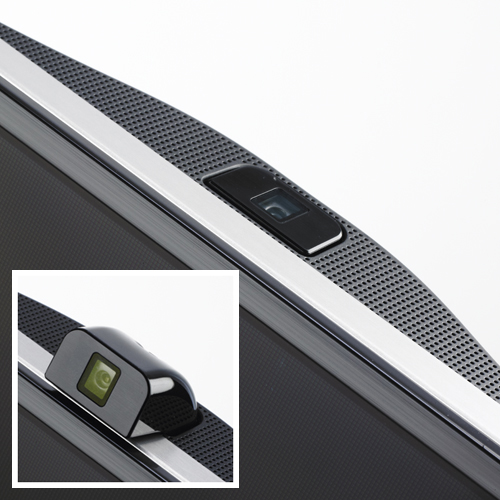
At the time of writing the app wasn't compatible with our Google Nexus 4 (Jelly Bean 4.2.2 OS) nor various older Android phones. We expect device compatibility will improve, however.
Samsung’s AllShare app lets you mirror media to and from your smartphone and TV. Make sure you’ve got the latest Android software update for all the apps to work. There are currently no plans for any iOS support.
Samsung UE55F8000 review: Smart Hub
The first thing you’ll see when you turn on your new Samsung UE55F8000 is the Smart Hub. Serving as both the homepage and the hub for all activity, Samsung’s Smart Hub has always been a shiny and colourful display, but the redesign takes it up another level.
It’s a slicker design, with tiles neatly arranged in a grid, and it takes cues from smartphone interfaces – for instance there’s a carousel effect when you swipe from one panel to the other.
Most people are now so used to smartphone touchscreen animations that it makes perfect sense to mimic the interface on to increasingly smarter TVs.
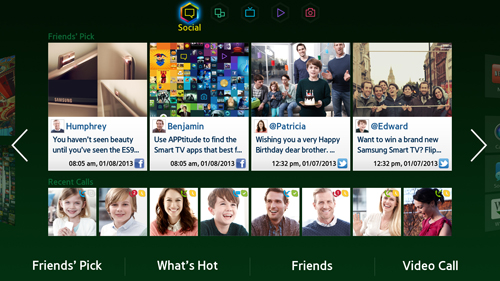
There are five panels for separate categories:
Social: displays all your social networking (Twitter, Facebook, Skype calls) – in one area. You can also pull up your Twitter feed when watching live TV shows, to keep up with the latest snippets of commentary.
Apps: the library of all the apps available. To name a few: BBCiPlayer, ITV Player, Demand 5, BBC Sport, YouTube, Netflix, Facebook, Twitter, Skype, LoveFilm, Acetrax, Spotify…
On TV: Broadcast TV is now integrated into the greater Smart Hub interface. Along with a panel showing the current channel, there are previews of what’s coming up on different channels as windows into current programmes on select few channels. You can access your recorded programmes from this panel, as well as toggling between the electronic programme guide and a timeline guide view.
Movies & TV Shows: aggregates all the movies and TV shows available across different online services, so you don’t have to log into them separately – a much neater way of displaying the choices available.
Photos, Videos and Music: displays all your stored media files
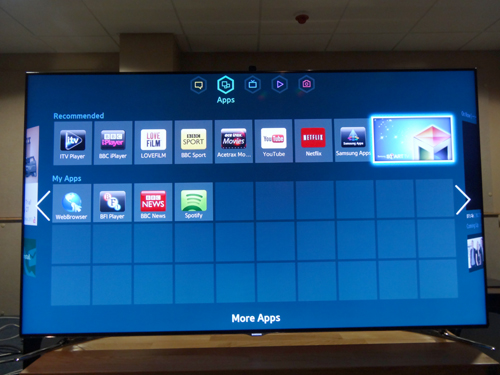
We really like the revamped Smart Hub interface: it’s a fun and intuitive way to move around the TV, and used in conjunction with the supplied Smart Touch remote (also given a face-lift), it’s smooth and highly responsive. We also like the animation effect of the Apps tiles folding up and down – a little trick that goes a long way when you’re living with the screen.
It makes you want to keep coming back to the home page – well, you have no choice, really, but having both smart features and broadcast TV seamlessly integrate into each other feels more organic: TV and Smart are one and the same.
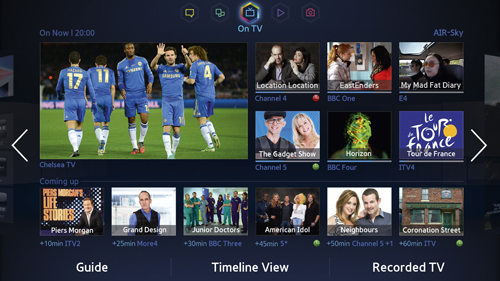
Samsung UE55F8000 review: Smart Touch remote
As mentioned before, the Smart Touch remote control has been given a redesign, and it’s a more polished and responsive remote than last year’s offering. It’s a partially metal design with a touch pad that’s intuitive and easier to use.
Once again, it comes down to people being so accustomed to the touch-screen sensitivity of smartphones, that using one has become second nature – and it makes sense to adapt that design for remote controls.
It serves Samsung well here, as it has great responsiveness when flicking through the Smart Hub panels, and also when moving a cursor using the web browser. You can even trace a channel number on the touchpad to change channels!
MORE: Samsung TVs get bigger and smarter led by Ultra HD TV
Of course, with its minimal button design, certain always-there buttons – like Mute, Menu, Tools etc – have to be accessed on the on-screen keypad via the ‘More’ button. It’s a bit of a bother if you’re used to having all the buttons at your convenience, but it’s not too much of an issue if you have the standard remote or smartphone app at hand – and it’s easy to get used to after a few clicks.
It’s a much more ergonomic design, and we found ourselves reaching for it as the dominant controller (over standard remote or the voice or motion controls.)

If you don’t get along with the Smart Touch remote, Samsung still provides the standard all-button remote. It’s largely the same unit as before, but we’ve been told it has a few changes – we’re still awaiting the new model at the time of writing.
Samsung UE55F8000 review: Voice and Motion Controls
Using hand gestures and voice commands to control your TV set might seem a step towards the future, but its full usefulness and employment remains in the realms of sci-fi.
Samsung introduced voice and motion controls in its 2012 range of TVs – and it met with mixed success.
On one hand, it’s an attention-grabbing and exciting feature that lets us marvel at how intelligent TVs are becoming; in practice though, it can be downright frustrating to make it work as smoothly as they do in sci-fi shows and films – but it does work. Both voice and motion have been given tweaks and improvements for the 2013 range, and it shows.
In contrast to last year, we found the motion controls to be much friendlier than the voice commands. For a start, it’s more responsive, with reduced lag between your hand movement being recognised on the TV, and movements are smooth, with fewer trailing or delay effects. The camera has to be popped on for motion controls to work, and it does get a bit confused if you’ve got more than one person waving frantically at it.
Patience is the key here (and steady hands), and it does get used to (and recognise) individual hands. You can also use two hands – yes, it really works! – to rotate and zoom in and out of pictures on the screen, as well as lazily flick your hand to the side to swipe across the Smart Hub panels – which we quite liked.
MORE: Samsung Galaxy S4 review
After the initial novelty and giddiness of it actually working, we still feel a bit daft waving at the TV and clenching our fist to select items, and ours arms ached after a while.
Switching to voice control, and the Smart Touch remote encourages you to speak directly to the remote (rather than shout at the TV hoping for the best) and it is more responsive than before.
However, the technology is still a bit hit-and-miss – it liked ‘Arsenal’ but not ‘Top Gear’ – and you’ll still feel self-conscious as you end up over-enunciating words to make it work. An on-screen guide pops up to give prompts on which command phrases to use – which is helpful, but still not ideal and certainly not as intuitive as using the Smart Touch remote.

Samsung UE55F8000 review: Sound
We’ve always been hard on the sound quality from any flat screen TV, and with good reason as it’s always hard, thin and uninspiring. Sony’s HX8 series marginally won the sound battle last year with its plinth stand that housed a speaker system – it took the edge off the thinness.
But Samsung has risen to the challenge and responded by packing in two 10W woofers alongside the two standard drivers that cover most of the frequency range – a total of 40W outputting from the UE55F8000.
And the effect is instant. By flatscreen standards, it’s a much more powerful, meatier and solid sound: it’s actually listenable on its own! There was noticeable (and comparatively weighty) bass, and voices sounded warm; there was little hint of brightness and overall it was comfortable and pleasant to listen to.
For a proper sonic experience, we’d still recommend pairing up your TV with a home cinema system or a soundbar – the recently launched Sonos Playbar (5 stars at £600) would be perfect for the UE55F8000.
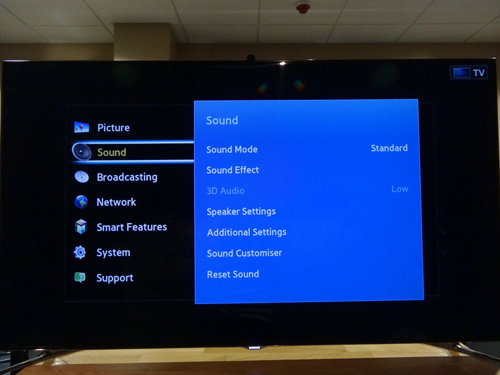
Samsung UE55F8000 review: Picture
Of course, what it all boils down to is this: what’s the picture quality like? In short, the UE55F8000 is a great screen. But as we noted earlier, it didn’t start out that way.
The picture performance is quite a departure from last year’s range: the 2012 Samsung screens aimed to delivered punchy colour, exciting contrasts and an overall impressive and eye-popping performance.
In contrast, this new 2013 screen is a much more grown-up affair: it’s calmed down that burst of exuberance, and might seem subdued at first glance. But look deeper, and the UE55F8000 serves up a more natural palette and composed performance.
MORE: Samsung 2013 TV range
The picture is remarkably clear and crisp – play The Amazing Spider-Man and the city skyscrapers are etched out in sharp lines, each building nicely distinguished from each other despite the shadows. In fact, this Samsung sometimes needs reigning-in – edges appearing too sharp, especially in 3D.
Close-up shots of the actors show off the UE55F8000’s deftness with natural tones: cheeks look ruddy and skin tones look natural and rounded. If we were being cruel, we could mention that every spot and blemish is displayed with clarity – which goes to show the depth of subtlety on show.
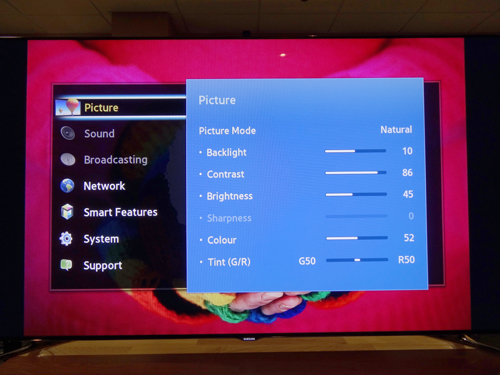
When the Samsung is compared with rival Sony KDL-55HX853 (last year’s Award-winner at £1440), the Sony may have a more subtle touch in digging out shadow detail, but the Samsung’s black levels go deeper thanks to its Micro Dimming Ultimate technology.
That said, the Philips 55PFL8008 and Panasonic TX-P55VT65 deliver even better black detail. The Samsung also fails to handle contrast quite as convincingly as its newer rivals, and while colours are realistic and edges clean, the picture can sometimes appear too sharp and needs reining in – especially in 3D.
Next to the Philips and Panasonic, the Samsung is a less dynamic experience in terms of contrast and detail. And while we admire the Samsung's understated whites (which sit just the right side of dull) and minimal picture noise, there's still the odd motion gremlin.
It’s worth playing around with the picture settings and modes to find the tone best suited to watching TV or film. For example, we found that it was best to leave the picture on Standard mode (with THX tweaks) when watching normal broadcast channels (standard or high definition).
When it came to the Blu-ray of The Amazing Spider-Man, we felt more comfortable setting it to Natural mode, and then fine-tuning the backlight and contrast levels from there. It delivered a much more satisfying balance: previously, skies looked overcast and black levels were grey and washed-out.
In Natural, whites were punchier and brighter, and The Lizard’s underground sewer hide out looks appropriately gloomy and wet. But overall, whites can be a little too understated.
Switch to 3D with Closer to the Edge, and Samsung’s active 3D performance is a brighter, clearer and less cumbersome affair. You’ll still feel your eyes working overtime (normal for active sets), and while motion isn’t perfect (in 2D or 3D), we welcome the improvements. Two pairs of active 3D glasses are supplied with the TV.

Samsung UE55F8000 TV review: Verdict
We really like the Samsung: it’s a cutting-edge set with improved smart features, a friendlier user experience, and a definite step up in both sound and picture performance.
But it’s not flawless: the motion and voice controls are far from perfect, and it’s quite an expensive price tag. And we liked the Samsung more when it was the first 2013 TV we'd seen at this size and price. Since then more new models have arrived on the scene, and after another critical look at it, it's clear that it can't quite compete against the very best from Panasonic and Philips. Therefore it loses a star.
MORE: Samsung PS51F5500 review
MORE: Best TVs 2013
Follow whathifi.com on Twitter
What Hi-Fi?, founded in 1976, is the world's leading independent guide to buying and owning hi-fi and home entertainment products. Our comprehensive tests help you buy the very best for your money, with our advice sections giving you step-by-step information on how to get even more from your music and movies. Everything is tested by our dedicated team of in-house reviewers in our custom-built test rooms in London, Reading and Bath. Our coveted five-star rating and Awards are recognised all over the world as the ultimate seal of approval, so you can buy with absolute confidence.


